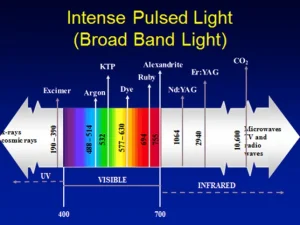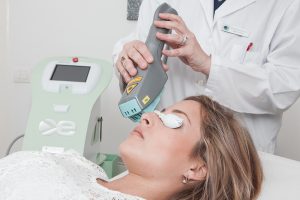One of the most common eye problems is dry eye, a condition that can have a very negative impact on quality of life, and recently, pulsed light technology has gained attention as a possible treatment for this annoying problem, offering new hope to sufferers.
Pulsed Light
 The Intense Pulsed Light (IPL) is an innovative technology using high-intensity light beams, which were initially applied to aesthetic treatments, but are now also being used for medical treatments.
The Intense Pulsed Light (IPL) is an innovative technology using high-intensity light beams, which were initially applied to aesthetic treatments, but are now also being used for medical treatments.
Unlike the laser, which employs a single wavelength, IPL uses a broad spectrum of light, allowing a larger area to be treated evenly.
Medical Uses of Pulsed Light
IPL is commonly used in dermatology to treat skin spots, wrinkles and other signs of ageing. Pulsed light works by penetrating the surface layers of the skin, stimulating collagen production and improving elasticity.
It is also used to treat pathological conditions such as rosacea, acne and pigmented lesions.
In ophthalmologyIPL is mainly used to treat dysfunction of the Meibomian glands, one of the main causes of dry eye. This treatment helps unblock blocked glands.
Benefits of Pulsed Light
The benefits of using pulsed light in medicine are numerous, as it is a non-invasive procedure, so the risk of complications is reduced.
In addition, the recovery time is generally short, making it a preferable choice for many patients seeking effective and quick solutions.
In dermatology, IPL treatment can improve skin texture, reduce dyschromia and smoothen superficial wrinkles. This makes it possible to achieve younger, brighter skin without resorting to surgery.
In ophthalmology, it can reduce dry eye symptoms and thus lead to a significant improvement in patients' quality of life.
Dry Eye
Dry eye is a widespread disorder that affects millions of people worldwide and is caused by reduced tear production or excessive evaporation of the tear film.
Dry Eye Symptoms
Symptoms of dry eye can vary from mild to severe and include a burning sensation, itching and redness. Many patients also report a foreign body sensation in the eye, as if there were sand in it.
Other frequent symptoms include blurred vision, sensitivity to light and difficulty wearing contact lenses. In some cases, dry eye may cause excessive tearing as a reflex response to dryness.
The severity of symptoms may vary throughout the day and worsen in dry or windy environments. If left untreated, dry eye can lead to more serious conditions, such as eye infections and damage to the corneal surface.
Pulsed Light and Dry Eye
 Pulsed light has emerged as a promising solution for the treatment of dry eye mainly through the stimulation of the Meibomian glands, which are located along the edge of the eyelids and produce an oily component of the tear film, which is essential to prevent excessive tear evaporation.
Pulsed light has emerged as a promising solution for the treatment of dry eye mainly through the stimulation of the Meibomian glands, which are located along the edge of the eyelids and produce an oily component of the tear film, which is essential to prevent excessive tear evaporation.
- Stimulation of glandsIPL improves the function of the meibomian glands, promoting the restoration of lipid production.
- Reduction of inflammationpulsed light has anti-inflammatory properties that help reduce inflammation of the eyelids, improving the stability of the tear film.
- Cleaning the glandstreatment helps unblock blocked glands, improving hydration and ocular comfort
Numerous studies have shown that IPL is effective in improving dry eye symptoms. Patients treated with pulsed light report a significant reduction in symptoms such as burning, itching and foreign body sensation.
Improvements are often evident after just a few treatment sessions, with results that can last for several months.
Pulsed light is a viable treatment option for those who do not respond to conventional treatments, offering an innovative approach to the management of dry eye.
However, it is essential that the treatment is performed by qualified professionals to ensure safety and effectiveness.
Recent Studies and Research
A study, Intense pulsed light for meibomian gland dysfunction: a systematic review and meta-analysis, published on Graefe's Archive for Clinical and Experimental Ophthalmology, showed that patients treated with IPL showed a significant improvement in tear film quality compared to those receiving conventional treatments. The benefits were observed for several months after treatment ended.
Another study showed that IPL can reduce eyelid inflammation, contributing to an overall improvement in ocular health.
Precautions
Despite its benefits, pulsed light is not suitable for everyone. People with certain medical conditions or who take certain medications should avoid it.
Those who should abstain from treatment include:
- People with sensitive skin or who suffer from photosensitive diseases;
- Patients taking drugs that increase light sensitivity;
- Pregnant or breastfeeding women.
In addition, anyone with active skin lesions or infections in the area to be treated should wait for healing before undergoing IPL. It is always advisable to consult a medical specialist before starting treatment to assess suitability.
Possible Side Effects
Although IPL is generally safe, some patients may experience mild adverse effects.
Common side effects include redness, swelling and sensitivity of the skin in the treated area. These symptoms are generally short-lived and resolve spontaneously within a few days.
In rare cases, burns or changes in skin pigmentation may occur.
It is essential that treatment is performed by a qualified professional to minimise these risks. Following the post-treatment instructions provided by your doctor can help reduce the risk of complications.
Conclusions
IPL offers a non-invasive and effective solution for treating dry eye. Benefits include improved function of the meibomian glandsa reduction in dry eye symptoms and an improvement in the quality of the tear film.
Patients report a significant reduction in symptoms of burning, itching and foreign body sensation. IPL is a viable option for those who do not respond to traditional treatments and offers lasting results with few side effects.
Future Perspectives of Pulsed Light
Future prospects for the use of pulsed light in the treatment of dry eye are promising. With further study and research, IPL could become an integral part of dry eye management, with standardised and widely accepted treatment protocols.
- Vegunta S, et al. Combination therapy of intense pulsed light therapy and meibomian gland expression (IPL/MGX) can improve dry eye symptoms and meibomian gland function in patients with refractory dry eye: A retrospective analysis. Cornea. 2016;35:318.
- Leng X, Shi M, Liu X, Cui J, Sun H, Lu X. Intense pulsed light for meibomian gland dysfunction: a systematic review and meta-analysis. Graefes Arch Clin Exp Ophthalmol. 2021 Jan;259(1):1-10. doi: 10.1007/s00417-020-04834-1. Epub 2020 Jul 28. PMID: 32725403.
- hin KY, Lim DH, Moon CH, Kim BJ, Chung TY. Intense pulsed light plus meibomian gland expression versus intense pulsed light alone for meibomian gland dysfunction: A randomized crossover study. PLoS One. 2021 Mar 4;16(3):e0246245. doi: 10.1371/journal.pone.0246245. PMID: 33662017; PMCID: PMC7932142.
